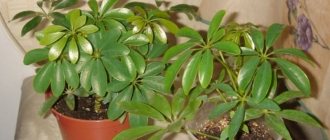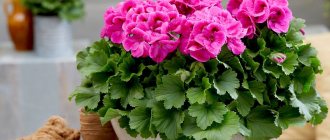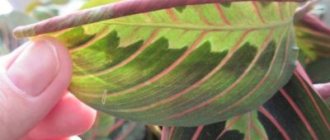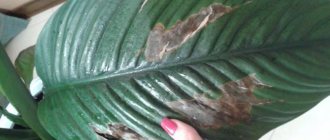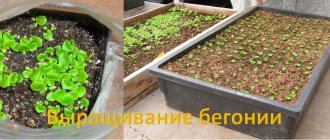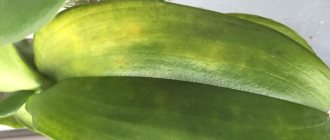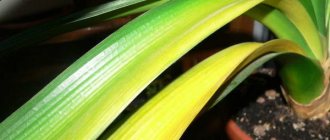Arrowroot is a very interesting, but, unfortunately, demanding plant. But if you are ready to satisfy her whims, she will thank you with very beautiful leaves. It’s difficult to even say what other indoor flowers can compete with arrowroot in the whimsicality of painted patterns on the leaves. Above there are dark green spots and white stripes on both sides of the central vein, below there are bluish-green leaves.
Why does arrowroot dry out?
Main causes of diseases
Arrowroot leaves curl and ends dry out, most often due to violation of maintenance conditions. Improper care is the main reason why a flower loses its decorative properties. A tropical plant requires long daylight hours, constant soil moisture, but without stagnant moisture, and frequent spraying.
Unsuitable conditions of detention
Errors in care that cause leaves to turn yellow and dry:
- Temperature indicators . Leaves dry out when the room temperature is above 25 °C in summer and 20 °C in winter. Cold and humidity, on the contrary, do not lead to drying out, but to softening of the foliage. The petioles become soft, bend towards the surface of the earth, and rotting begins.
- Lighting. Direct sunlight is harmful to arrowroot leaves. They can leave burns on their surface and lead to twisting. A characteristic sign of such a problem is yellowed spots that become thinner and even form holes on the surface of the leaf blade. If the flower is on a south window, it needs to be darkened. In general, it is better to place pots with arrowroot in the west or east. If there is a lack of lighting, the leaves will curl into a tube.
- Cold drafts. Sharp temperature fluctuations cause leaves to fall off from hypothermia.
- Soil composition . Arrowroot foliage dries out or becomes covered with brown spots if there is a lack of nutrients in the soil. The soil should be acidic, constantly slightly moist, but not too wet. Be sure to apply fertilizers every two weeks in the summer, and in winter - once a month, alternating organic mixtures and ready-made mineral complexes.
When watering arrowroot, you should use only water at room temperature or slightly warmer. Cold water damages thin roots, the plant stops growing and developing, new leaves do not appear, and the flowering phase is often absent.
Care errors
One of the main reasons for yellowing is improper watering . If the soil is too dry, the upper leaves of the flower turn yellow, fall off, or curl into a tube. The plant withers if the upper third of the soil layer dries out, since it is in this zone that the bulk of the root system is located. You need to water up to 3 times a week in the hot season and once a week from late autumn to early spring. If there is excess moisture in the pot, the stems begin to rot, the leaves become damp, dark, soft, and crumble. Excess moisture at low temperatures is especially destructive for arrowroot - under these conditions, root rot often develops, which can lead to the death of the flower.
A deficiency of essential nutrients also has a bad effect on the plant . Lack of nutrition, especially nitrogen, potassium and phosphorus, causes a slowdown in the growth of green mass. It is recommended to apply complex fertilizers containing more nitrogen from the beginning of spring, and by summer switch to fertilizers with potassium, phosphorus and other elements. Also, to ensure that the plant receives all the necessary substances, alternate mineral mixtures with organic ones.
Low air humidity causes the leaves to curl and dry out. Arrowroot is one of the most moisture-loving plants, so it is recommended to grow it not in a separate pot, but in a florarium , which protects the soil from moisture evaporation. Dry air leads to the fact that the tips dry out first, then the entire surface, the trunks become elongated and thin. Plants are more susceptible to pest attacks and root rot. In summer it is recommended to spray the flower up to 2 times a day, and in winter - 1 time every 3 days and even more often if the air in the room is too dry. As an option, you can install a humidifier next to the pot, cover the tree trunk with moistened moss, or place containers of water nearby.
Yellowing of leaves in the lower zone, almost above the very surface of the earth, may be a physiological norm . Plants that are more than 4–5 years old do not fully absorb nutritional components from the soil, and therefore lose some of their leaves. Drying of the leaves at the top should alert you - this most likely signals a disease or improper care. Once a year or less often, it is recommended to carry out sanitary pruning for a plant that has lost its decorative effect. Use sharp tools, and sprinkle all cuts with crushed charcoal or activated carbon.
Pest attacks
Sometimes arrowroot dries due to attacks by insect pests:
- Spider mite. A small insect that settles on almost any indoor plants. Its appearance is indicated by thin whitish threads, similar to cotton wool, that cover the underside of the leaf blade and petioles. The leaves inside become pale, after which they turn yellow and dry out. Spider mites feed on juices extracted from soft petioles and young leaves.
- Mealybug. A small oval insect of whitish or gray color. They feed on juices obtained from leaves. In the place where the insect bites through the leaf blade, you can see small holes. The infected plant begins to wither, turns yellow, the foliage first becomes covered with spots, which then merge and cover the entire surface.
- Shield . A brown or yellow oval-shaped insect that also feeds on juices. If the infection is too severe, the growth and development of the flower stops, the leaves curl, become like thin parchment, and turn yellow. The danger of the insect is that its waste products - sticky honeydew - are a breeding ground for the fungus. If the area of infection is more than 60%, the flower cannot be treated.
- Thrips. Small brown-yellow or dark brown insects up to 2 mm in length. They infest the leaves, causing them to change color, becoming whitish on top and spotted inside. They develop more often in conditions of high humidity and elevated temperature in the room, actively affecting neighboring flowers in the room.
In the initial stages, the flower can be saved using traditional methods, for example, washing it with soap and water or treating it with tinctures of calendula, garlic, or oregano. In difficult cases, insecticides must be used, and treatment is carried out at least 3 times with a break of 7 days.
General rules for caring for arrowroot at home
The plant is afraid of drafts and temperature changes. In winter, in the rooms where arrowroot grows, the air temperature should drop no lower than 12 degrees, preferably 16-18; in summer, the most optimal temperature is 23-24. To preserve the beauty and brightness of the leaves, you must follow several rules.
Since excessive lighting can cause the color of the leaves to fade, the plant must be shaded. At the same time, excessive shadow also negatively affects its color.
If the tips of arrowroot leaves become dry and brown or the leaves fall off, this may indicate excessive dry air. Yellow-brown tips indicate a lack or, conversely, an excess of nutrients. In drafts, the leaves curl and dry out.
Maranta. © Steven Rodriquez
The plant should be watered with moderately soft water, approximately room temperature; in winter, watering should be limited. Excess moisture may cause the plant's roots to rot. Dry and wilted leaves should be removed. To prevent the bush from stretching, it is cut off. The cuttings are cut together with the node from which the leaves grow. This promotes more intensive formation of new leaves.
So, for successful cultivation of arrowroot you need: partial shade , high air humidity , rich soil , and a fairly spacious pot .
Also, the plant cannot tolerate the presence of lime in the soil.
A little secret: add a couple of pieces of charcoal to the soil mixture for planting arrowroot. In spring and summer, it should be fed with flower fertilizers once every two weeks. Arrowroot shoots are creeping, so it is better to plant it in wide containers. Replant once every 1-2 years in the spring. The plant itself is compact, growing only 30 cm tall.
Maranta. © elka52
Control and prevention measures
Treatment of arrowroot consists of normalizing living conditions and timely identification of pests and diseases:
- Monitor air humidity. It should not exceed 70-75%, but also not be below 60%. You can maintain the desired parameters using household humidifiers, regular spraying and bathing in the shower.
- All plants dry at high room temperatures. In the heat of summer, create artificial shade for the flower and place the pot on the floor, where the air is cooler.
- Inspect the flower at least once every 2 weeks. If sticky secretions, holes, or cotton-like fragments appear, you need to wash the plant with soapy water, wipe the large leaves of the flower with vegetable oil, and, if necessary, use insecticide solutions for spraying.
Leaves can also dry out on flowers that are never replanted. In 3-4 years, the plant completely depletes the soil, drawing out all the nutritional components from it. The root system, located in a cramped environment, partially dies off, which is why the flower does not receive the substances it needs for growth. Repot annually for the first 4 years and then as needed.
Why does arrowroot dry out?
Arrowroot is a very interesting, but, unfortunately, demanding plant. But if you are ready to satisfy her whims, she will thank you with very beautiful leaves. It’s difficult to even say what other indoor flowers can compete with arrowroot in the whimsicality of painted patterns on the leaves. Above there are dark green spots and white stripes on both sides of the central vein, below there are bluish-green leaves.
Why does arrowroot dry out?
Content:
What to do if arrowroot leaves turn yellow and dry? Main diseases and pests
No matter how hard the gardener tries to keep his pets in comfortable conditions, sometimes it is not possible to avoid certain diseases that will spoil the appearance of the flower and can even lead to its death.
Basically, many diseases that affect indoor plants arise due to improper care, watering regime and unfavorable environment.
Signs and superstitions about arrowroot
It is believed that the plant is able to absorb aggression, protecting the house from quarrels and disagreements. According to the practice of Feng Shui, the energy of the tricolor arrowroot species prevents the occurrence of colds and is capable of purifying the blood.
Author: Natalya February 17, 2021 Category: Indoor plants
plant (lat. Maranta) is a representative of the genus of perennial grasses of the Marantaceae family. The genus includes about 25 species growing in the tropical zone of America. The plant was named in honor of Bartolomeo Maranta, a medieval doctor and botanist. Arrowroot also has other names - prayer plant, praying grass, “ten commandments” (based on the number of spots on the leaves of one type of arrowroot) and arrow-shaped root. Arrowroot flowers are decorative foliage plants, and not at all flowers in our usual sense, but their leaves are a real masterpiece created by nature.
Manifestations of diseases, causes, treatment
Leaves turn yellow and dry
The leaves or their tips first turn pale, then acquire a brown tint and dry out - a symptom of sunburn .
Why do arrowroot leaves turn yellow and dry? She does not like bright light, especially direct sunlight. She likes soft, diffused light.
If you notice similar symptoms on the leaves, immediately move the plant to another place, less bright, or diffuse the light. To do this, you can shade the window with matte paper or fabric.
The photo shows a selection of dry arrowroot leaves:
Why do the leaves curl?
Why do arrowroot leaves curl? Plants turn yellow and dry, fall off, slow growth of the plant, yellowing of the lower leaves - all these are symptoms of insufficiently moist air or dry soil.
Or both together. How to save arrowroot? Remove dead leaves, surround the flower with moist peat - it has increased moisture capacity and will moisturize the plant well. Keep the flower away from radiators in winter.
Use household humidifiers and spray the leaves regularly. Excessive dry air can lead to spider mite damage to the plant.
Remember to keep the soil moist . In summer, the flower requires abundant watering, in winter - moderate. Do not over-moisten the soil, otherwise the plant will get sick.
The trunk and rhizome rot
The trunk and rhizome rot - waterlogging of the soil, cold. The stems have not completely rotted yet - there is a chance to save Maranta.
Urgently move the flower to another pot, removing everything rotten. Fertilize the soil with a mixture for decorative houseplants.
In autumn-winter, reduce watering. Maintain the temperature at a level favorable for the plant - in summer from 22 to 25 degrees Celsius, in winter from 15 to 20.
Yellowish-brown leaf tips
Yellowish-brown leaf tips, slow growth - lack of nutrition.
It is necessary to feed the plant with mineral-organic fertilizer. Feeding is carried out all year round, in spring - summer - once every two weeks, in autumn - winter - once a month.
Brown spots
The appearance of brown spots on the leaves is due to waterlogging by spraying . Try to spray less thoroughly, away from the plant.
Spider mite
It affects leaves and settles mainly on their reverse side. The leaves lighten, turn yellow, and have white spots and cobwebs on them. Soon the leaves fall.
Spider mites are small arthropods. It is barely visible to the naked eye, has a size of 0.2–0.4 mm , translucent, greenish or yellowish-red. It is a dangerous parasite that can lead to the death of the plant.
Solutions of tobacco with soap have minimal effect; it is better to use pesticides .
Arrowroot for spraying should be taken out of the room.
It is necessary to thoroughly irrigate the trunk and leaves . If you applied acaricides, re-treatment is required after a week. In the case of insecticides, the treatment must be repeated more than three times.
To prevent infection, regularly spray the plant with cool water, humidify the air, rinse the arrowroot, and keep it clean. Inspect periodically.
Mealybug
Affects arrowroot leaves. The leaves dry out and fall off. The shoots stop growing and the plant withers. The parasite is easily detected - cotton wool clusters appear on the leaves, which cover the pest.
The mealybug is a sedentary arthropod measuring from 3 to 5 mm ; it has transverse grooves on its back and is covered at the edges with a white coating reminiscent of flour, which is where its name comes from. The insect feeds on the sap of the plant, while simultaneously injecting its poison into it. This creates conditions for the flower to quickly wither.
If the parasite is detected in a timely manner, it can be dealt with by washing the arrowroot leaves with a soap solution (20 g of soap per liter of water). You can use a cotton swab moistened with an alcohol solution diluted to forty degrees.
If the flower is severely affected by the parasite, it is necessary to use chemicals such as mosplan or fufafon . Perform the procedure three times at intervals of a week.
It affects the leaves and stems of the plant. The pest sucks the sap of the flower, weakening it. The shoots become bent and the growth of Maranta slows down significantly. A sticky coating forms on the leaves - parasite secretions. A fungus may develop on the plaque, which will further aggravate the situation - the plant will have nothing to breathe and will quickly die.
The scale insect is a relative of the mealybug; it also drinks the juices of the plant and secretes its toxic substances into it, only this parasite is even more cruel and invulnerable. Within a few days, colonies of the pest can cover the entire plant.
Scale insects have sizes from 0.5 to 5 mm , on top they are covered with a waxy rounded shield of a brownish tint, which protects them from external influences and makes them almost invulnerable to insecticides.
If the parasite has just begun its development, measures should be taken to destroy it.
Since this pest is very difficult to control, the destruction of the parasite is carried out in several stages:
- Rinse Maranta in a shower with water temperature no higher than 40 degrees. This way, some of the larvae and adult insects will be washed away.
- Next, you should thoroughly wipe the leaves with a soapy sponge or cotton wool moistened with 70% alcohol, removing all pests.
- Then dry the arrowroot and treat it with bitoxibacillin and vertitmek .
- After a week, the entire cycle must be repeated regardless of whether you see the parasite (the larvae are very small and may not be noticed).
Take the treatment of the plant very seriously - just one living larva will negate all your efforts - after a few days the plant will again be covered with a sticky coating.
Arrowroot is a heat-loving flower that requires careful care. Even excessive ventilation of the room can affect its health. All diseases are associated precisely with improper care of her. Therefore, careful attention and care for this beautiful plant will contribute to its health for a long time.
Frequently Asked Questions: Maranta
| General information on caring for arrowroot. |
1. In arrowroot, new leaves appear light green and small, although all other leaves are dark green, as expected. What's wrong?
Answer:
Arrowroot leaves may turn pale from too much or too little light. Place the arrowroot in a less shaded place (but not in the sun, of course), or move it to the shade. Large, bright leaves require partial shade, high humidity, a large (but moderate) pot and very rich soil. Although it’s easy to check - if it’s dark, it doesn’t drop its leaves. It took me a long time to move my beauty from place to place. I started from a place away from the window. She stood spread-eagled the entire time. I moved her closer, and so on until she began to drop her leaves during the day.
2. Is it necessary to form an arrowroot bush? How to do it?
Answer:
Necessary! Then you will get a fluffy low bush. Try to cut it so that on the cut cutting there is such a bump - a knot where a bunch of leaves originates; place the cutting in water. Roots begin to grow from this nodule. Then put it in the pot with “mom” or give it to someone. And the arrowroot will begin to intensively “grow” with new leaves.
3. How to propagate it?
Answer:
Arrowroot is propagated not by leaves, but by stem cuttings. A more or less long shoot with a “knee” must be cut off a cm below this very “knee” and placed in water. The roots form quite quickly and grow from the “knee”. The size of the entire plant does not matter, it is only necessary that it be healthy and growing well. The “knee” is where the leaf attaches to the stem. Cut 1-2 cm below this place. It’s better to make several cuttings just in case. If the cutting will be without water for some time, then cut it 3-4 cm below the node, and cut off the excess before lowering the cutting into water. If the cuttings begin to wither in water, cover them with a cap until the roots grow. Or - by dividing the bush when transplanting. All other arrowroots reproduce in the same way.
4. The tips of the leaves dry out:
Answer:
Did you replant it after purchasing it, and if “yes,” then how? All Dutch peat must be removed from plants - it contains a lot of nasty things, incl. growth inhibitors, so it may not grow on you. Did the leaves dry out in the summer? If so, then most likely the air is dry, and spraying is useless - it moisturizes it for a very short time, it is better to place it around a container of water or place the plant on a tray with constantly wet expanded clay. And if the leaves began to dry only in the fall, then perhaps it is cold - put it where it is warmer. You can also carefully remove it from the pot and see what is there - perhaps the roots are rotting, arrowroot plants do not like excessive watering, the soil should dry out a little, especially in winter, when the temperature drops. Yes, by the way, arrowroot trees can be replanted at any time of the year, but they cannot be divided in winter, so you can still try to change the soil for it - a lot depends on this. The soil should be slightly acidic, very loose (add sand and at least a little good non-Dutch peat to the finished substrate. And also, the leaves dry out and curl from drafts. In general, arrowroot is demanding on the location: it should not be cold and dry, not straight sun, but not shade, no drafts, really doesn’t like moving around or walking past. She needs to get used to the new place a little.
Common problems when growing arrowroot: how to fix them
The appearance of the plant may indicate that the growing or care conditions have been violated, as a result of which the arrowroot leaves turn yellow or curl, dry out or fall off. To understand the reason for these changes, it is necessary to consider each sign separately.
Leaves are drying
Drying out of the sheet plate can occur as a result of too low a humidity level when the air is too dry, for example, due to the heater being on. To eliminate this phenomenon, it is necessary to fertilize the soil in the pot using mineral fertilizers, and to increase humidity, you can use a household humidifier.
How to deal with arrowroot diseases
Changes in the external appearance of the plant may occur as a result of one of the diseases characteristic of arrowroot.
Anthracnose
The fungus that infects leaf blades looks like gray-brown spots. In the center of small areas of lesions in the form of circles, you can see red and deep orange tubercles containing fungal spores.
- increased soil acidity;
- high air humidity.
To eliminate a fungal disease, you should remove infected leaves and shoots and irrigate the plant with any fungicidal agent. If the plant was treated twice and did not produce results, then the arrowroot will have to be thrown away along with the pot.
Brown and black fusarium rot
- Black rot is a fungus that attacks heat-loving arrowroot if it enters a room with too low an air temperature. The areas of the plant damaged by the fungus are removed, and the flower itself is transplanted into a new substrate. The plant and its neighbors are treated with Bordeaux mixture for prevention and subsequently adhere to the correct maintenance conditions.
- Brown rot is a fungal disease that is marked by dark brown rot of the root collar and apex of the plant's tap root. The disease spreads around and girdles the stem, causing it to become soft and mushy in texture. This disease occurs as a result of violation of the conditions of detention, when the temperature in the room is low with high humidity. For preventive purposes against brown rot, irrigation with copper sulfate can be used.
Sooty fungus
The disease appears as a gray spot or a darker shade. The plaque grows rapidly, combining several small spots into one large one. You can eliminate it by wiping the sheet with a wet cloth or sponge.
The appearance of this disease is caused by the activity of pests, therefore, in order to completely eliminate the disease, their presence and affiliation should be determined. Ventilation is used for preventive purposes, but access to fresh air should exclude drafts.
spotting
Brown spots on leaf blades can appear due to various reasons, the main of which is high humidity. To remove such spots, you can use a weak solution of potassium permanganate to treat all leaves, and then it is recommended to transplant the plant into a new pot.
Types and varieties
White-veined arrowroot (Maranta leuconeura)
An inhabitant of Brazilian tropical forests with a short (25-30 cm tall) stem, oval leaves, up to 15 cm long, up to 9 cm wide, on petioles up to 2 cm long. The upper side of the leaf is dark green, with a silvery side running down its center the stripe, lateral veins are silvery-white with a light green pattern, the underside of the leaf is reddish or bluish-green.
This species is rarely found in culture; its varieties are grown more often:
- Kerchoven's variety (Maranta leuconeura var. kerchoveana) - the upper side of the leaf blade is bright green with dark green spots in the shape of eyes and feathers, a white stripe runs along the central vein, the underside has a red tint with a blue tint;
- variety Masange (Maranta leuconeura var. massangeana) - a variant of the Kerkhoven variety, but the spots are not dark green, but olive-brown;
- red-veined or tricolor variety (Maranta leuconeura var. erythrophylla or Maranta tricolor) with leaves from light green to dark green, lighter towards the periphery. There are yellow-green and light green spots along the central vein. The leaves are velvety, dark crimson on the underside.
Maranta bicolor
It is distinguished by oval, slightly wavy leaves up to 15 cm long on a short reddish petiole. The upper side of the leaves is green with dark green and brown spots along the central vein; the leaves are pubescent underneath.
Reed arrowroot (Maranta arundinacea)
A compact shrub up to 120 cm high with long, up to 25 cm, ovate, pubescent leaves below, dark green with a bluish tint.
Any type or variety of the plant is worth the effort and time spent on growing it, since the exquisite beauty of arrowroot leaves leaves no one indifferent.
The main pests of arrowroot and ways to combat them
Deterioration in the health of arrowroot may occur due to the influence of pests, among which scale insects and mealybugs most actively affect the plant.
Shchitovka
This pest attacks the leaves and stems of the flower, sucking the juice from the plant. As a result, the shoots become deformed, curved and the growth of arrowroot slows down. The scale insect leaves its traces on the leaf blades in the form of sticky secretions. This coating remains on the surface of the leaf and fungal spores develop in it, which do not allow the flower to breathe fully, which leads to the death of the arrowroot.
The scale insect spreads very rapidly, increasing the affected area day by day, and in a few days it can cover the entire plant. Small pests have a size of 0.5–5 mm, protected by a wax shield that protects them from external influences, including insecticides.
To get rid of this pest, it is recommended to take a number of measures:
- Bathe the flower in the shower, washing it with warm water, the temperature of which should not be higher than +40°C. This will wash away the adults and some of the larvae.
- This is followed by treating the arrowroot with soapy water using a cloth or 70% alcohol using a cotton pad. The procedure is aimed at removing remnants of scale insects from the plant.
- After the plant has dried, it is wiped with a solution of Bitoxibacillin or Vertimek.
All these steps must be repeated a week later, even if no traces of activity or parasites themselves are found. If you do not re-process it or do it poorly, scale insects will soon appear again.
Spider mite
This tiny pest, 0.2–0.4 mm in size, is an arthropod. It is thanks to its miniature size and translucent color that it is extremely difficult to notice a spider mite.
The actions of this pest are very dangerous for the plant: the back side of the leaf is damaged, it becomes lighter, then turns yellow, white spots and cobwebs appear. As a result, the leaves fall off and the plant itself may die.
Control methods can be different and depend on the degree of damage to the arrowroot:
- treatment of leaves with tobacco solution;
- wiping sheet plates with soapy water;
- acaricides - chemical substances to combat ticks;
- insecticides are chemicals used to control insects.
The procedure for getting rid of spider mites should be as follows:
- The plant must be taken out of the living space and moved, for example, to the bathroom.
- Treat the leaves and stem of the flower with a chemical composition. If acaricides are used, the treatment is carried out twice, with the procedure repeated a week later. If the primary treatment was carried out using insecticides, then it must be repeated at least 3 times.
Prevention of the appearance of the pest is to irrigate the plant with cool water, well-humidified indoor air, and periodically bathing the plant. Growing arrowroot at home does not require much trouble, and most of the diseases from which the plant suffers arise as a result of violation of the conditions of maintenance. By controlling the correct temperature and humidity levels, you can keep this beautiful flower healthy.
What to do if arrowroot leaves turn yellow and dry? Main diseases and pests
No matter how hard the gardener tries to keep his pets in comfortable conditions, sometimes it is not possible to avoid certain diseases that will spoil the appearance of the flower and can even lead to its death.
Basically, many diseases that affect indoor plants arise due to improper care, watering regime and unfavorable environment.
Manifestations of diseases, causes, treatment
Leaves turn yellow and dry
The leaves or their tips first turn pale, then acquire a brown tint and dry out - a symptom of sunburn .
Why do arrowroot leaves turn yellow and dry? She does not like bright light, especially direct sunlight. She likes soft, diffused light.
If you notice similar symptoms on the leaves, immediately move the plant to another place, less bright, or diffuse the light. To do this, you can shade the window with matte paper or fabric.
The photo shows a selection of dry arrowroot leaves:
Tip: to make the plant recover faster, feed the flower.
Why do the leaves curl?
Why do arrowroot leaves curl? Plants turn yellow and dry, fall off, slow growth of the plant, yellowing of the lower leaves - all these are symptoms of insufficiently moist air or dry soil.
Or both together. How to save arrowroot? Remove dead leaves, surround the flower with moist peat - it has increased moisture capacity and will moisturize the plant well. Keep the flower away from radiators in winter.
Use household humidifiers and spray the leaves regularly. Excessive dry air can lead to spider mite damage to the plant.
Tip: to humidify the air, you can spray water on the fabric of the curtains at the bottom, where the radiators are located. The heat from the batteries will help humidify the air faster.
Remember to keep the soil moist . In summer, the flower requires abundant watering, in winter - moderate. Do not over-moisten the soil, otherwise the plant will get sick.
Important: water for irrigation must be warm, soft, have a low calcium content or its complete absence.
The trunk and rhizome rot
The trunk and rhizome rot due to waterlogging and cold. The stems have not completely rotted yet - there is a chance to save Maranta.
Urgently move the flower to another pot, removing everything rotten. Fertilize the soil with a mixture for decorative houseplants.
In autumn-winter, reduce watering. Maintain the temperature at a level favorable for the plant - in summer from 22 to 25 degrees Celsius, in winter from 15 to 20.
Yellowish-brown leaf tips
Yellowish-brown leaf tips, slow growth - lack of nutrition.
It is necessary to feed the plant with mineral-organic fertilizer. Feeding is carried out all year round, in spring - summer - once every two weeks, in autumn - winter - once a month.
Important: Maranta does not like overfeeding, so reduce the amount by half. Dilute fertilizers with double portions of water.
Brown spots
The appearance of brown spots on the leaves is due to waterlogging by spraying . Try to spray less thoroughly, away from the plant.
Botanical description
Indoor arrowroot flower is a plant with a tuberous rhizome, its leaves are elliptical in shape, basal or double-rowed on the stems. The colors of the leaves are varied and incredibly beautiful: the background color varies from almost white to dark green, and bright spots, stripes and veins stand out against the background. The upper side of the leaf is much brighter than the bottom, and this is especially striking when the arrowroot flower makes its “prayer”: in the evening it raises the leaves and slightly folds them so that only the plain underside of the plates is visible, and in the morning it lowers and unfolds its beautiful leaves, the sight of which inspires admiration every time.
- Homemade medicinal plants
Indoor arrowroot blooms with white, cream or lilac asymmetrical three-membered flowers, collected in apical spike-shaped inflorescences. The flowering of arrowroot is not God knows what a spectacle, so it is better to remove the flowers immediately so that the plant does not waste its energy. The fruit of the arrowroot is a single-seeded capsule. The indoor arrowroot plant rarely grows above 30-40 cm in height, so it can be kept in any, even the smallest room, although natural plant species sometimes reach 150 cm in height.
Caring for arrowroot flowers is not as difficult as is commonly believed, so even a novice gardener can grow this treasure.
Pests
Spider mite
It affects leaves and settles mainly on their reverse side. The leaves lighten, turn yellow, and have white spots and cobwebs on them. Soon the leaves fall.
Spider mites are small arthropods. It is barely visible to the naked eye, has a size of 0.2–0.4 mm , translucent, greenish or yellowish-red. It is a dangerous parasite that can lead to the death of the plant.
Solutions of tobacco with soap have minimal effect; it is better to use pesticides .
Important: only acaricides are effective in getting rid of spider mite egg clutches.
Arrowroot for spraying should be taken out of the room.
Important: take precautions, as any toxic chemicals are harmful to health.
It is necessary to thoroughly irrigate the trunk and leaves . If you applied acaricides, re-treatment is required after a week. In the case of insecticides, the treatment must be repeated more than three times.
To prevent infection, regularly spray the plant with cool water, humidify the air, rinse the arrowroot, and keep it clean. Inspect periodically.
Mealybug
Affects arrowroot leaves. The leaves dry out and fall off. The shoots stop growing and the plant withers. The parasite is easily detected - cotton wool clusters appear on the leaves, which cover the pest.
The mealybug is a sedentary arthropod measuring from 3 to 5 mm ; it has transverse grooves on its back and is covered at the edges with a white coating reminiscent of flour, which is where its name comes from. The insect feeds on the sap of the plant, while simultaneously injecting its poison into it. This creates conditions for the flower to quickly wither.
Video: Pests and diseases of cabbage
If the parasite is detected in a timely manner, it can be dealt with by washing the arrowroot leaves with a soap solution (20 g of soap per liter of water). You can use a cotton swab moistened with an alcohol solution diluted to forty degrees.
Important: the surface where the plant stands must be thoroughly washed.
If the flower is severely affected by the parasite, it is necessary to use chemicals such as mosplan or fufafon . Perform the procedure three times at intervals of a week.
Propagation of arrowroot by cuttings
How to propagate arrowroot from cuttings photo
Propagation by cuttings is carried out in late spring and summer. Each cutting should have 2-3 leaves. Root in water - roots will appear in 5-6 days. Plant young plants in accordance with the transplantation rules.
